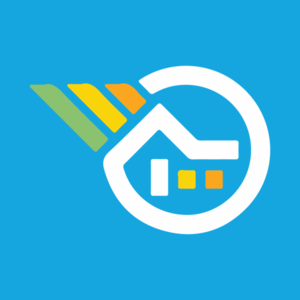
Generac (GNRC)
Generac doesn’t excite us. Its poor sales growth and falling returns on capital suggest its growth opportunities are shrinking.― StockStory Analyst Team
1. News
2. Summary
Why We Think Generac Will Underperform
With its name deriving from a combination of “generating” and “AC”, Generac (NYSE:GNRC) offers generators and other power products for residential, industrial, and commercial use.
- Anticipated sales growth of 4% for the next year implies demand will be shaky
- A consolation is that its market share has increased this cycle as its 14.5% annual revenue growth over the last five years was exceptional


Generac falls below our quality standards. Better businesses are for sale in the market.
Why There Are Better Opportunities Than Generac
High Quality
Investable
Underperform
Why There Are Better Opportunities Than Generac
At $127 per share, Generac trades at 15.7x forward P/E. Yes, this valuation multiple is lower than that of other industrials peers, but we’ll remind you that you often get what you pay for.
Cheap stocks can look like a great deal at first glance, but they can be value traps. They often have less earnings power, meaning there is more reliance on a re-rating to generate good returns - an unlikely scenario for low-quality companies.
3. Generac (GNRC) Research Report: Q1 CY2025 Update
Power generation products company Generac (NYSE:GNRC) beat Wall Street’s revenue expectations in Q1 CY2025, with sales up 5.9% year on year to $942.1 million. Its non-GAAP profit of $1.26 per share was 30.4% above analysts’ consensus estimates.
Generac (GNRC) Q1 CY2025 Highlights:
- Revenue: $942.1 million vs analyst estimates of $919.4 million (5.9% year-on-year growth, 2.5% beat)
- Adjusted EPS: $1.26 vs analyst estimates of $0.97 (30.4% beat)
- Adjusted EBITDA: $148.9 million vs analyst estimates of $129.2 million (15.8% margin, 15.3% beat)
- Full-year revenue guidance lowered: 0-7% growth expected vs prior 3-7%
- Operating Margin: 8.9%, up from 7.5% in the same quarter last year
- Free Cash Flow Margin: 2.9%, down from 9.6% in the same quarter last year
- Market Capitalization: $6.75 billion
Company Overview
With its name deriving from a combination of “generating” and “AC”, Generac (NYSE:GNRC) offers generators and other power products for residential, industrial, and commercial use.
Generac was founded in 1959 as a small manufacturer of portable generators. Over time, the company was able to expand by making various acquisitions. Its acquisition strategy is geared towards both consolidation within its core markets and diversification into new product offerings. For example, its acquisition of ECM in 2020 allowed it to expand its portfolio of outdoor power equipment including pressure washers.
Generac’s product portfolio includes generators, power storage systems (store electricity), pressure washers (use high-pressure water to clean surfaces), and other power products. The company is particularly well-known for its residential standby generators which provide homeowners with reliable backup power during outages. In addition, the company supplies portable and standby generators for commercial use and industrial generators and power systems for large-scale facilities that require continuous power. While it mainly focuses on selling equipment, it also offers maintenance and repair services for its products.
Generac primarily sells through one-time sales distribution through dealers, retailers, and online platforms. While it mainly focuses on selling equipment, it also offers maintenance and repair services for its products. Specifically, it engages in long-term service contracts that typically range from one to five years.
4. Renewable Energy
Renewable energy companies are buoyed by the secular trend of green energy that is upending traditional power generation. Those who innovate and evolve with this dynamic market can win share while those who continue to rely on legacy technologies can see diminishing demand, which includes headwinds from increasing regulation against “dirty” energy. Additionally, these companies are at the whim of economic cycles, as interest rates can impact the willingness to invest in renewable energy projects.
Competitors of Generac include Cummins (NYSE:CMI), Eaton (NYSE:ETN), and private company Kohler.
5. Sales Growth
A company’s long-term performance is an indicator of its overall quality. Any business can have short-term success, but a top-tier one grows for years. Over the last five years, Generac grew its sales at an exceptional 14.5% compounded annual growth rate. Its growth beat the average industrials company and shows its offerings resonate with customers.
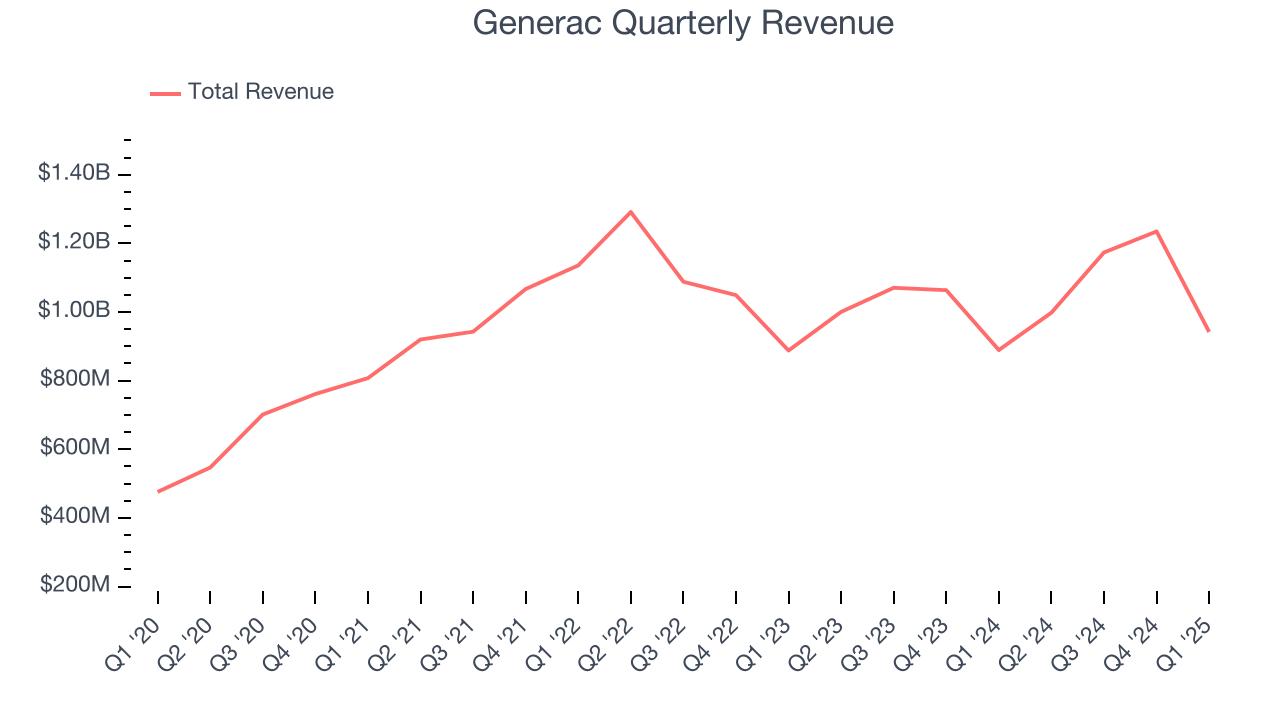
Long-term growth is the most important, but within industrials, a half-decade historical view may miss new industry trends or demand cycles. Generac’s recent performance shows its demand has slowed significantly as its revenue was flat over the last two years. We also note many other Renewable Energy businesses have faced declining sales because of cyclical headwinds. While Generac’s growth wasn’t the best, it did do better than its peers. 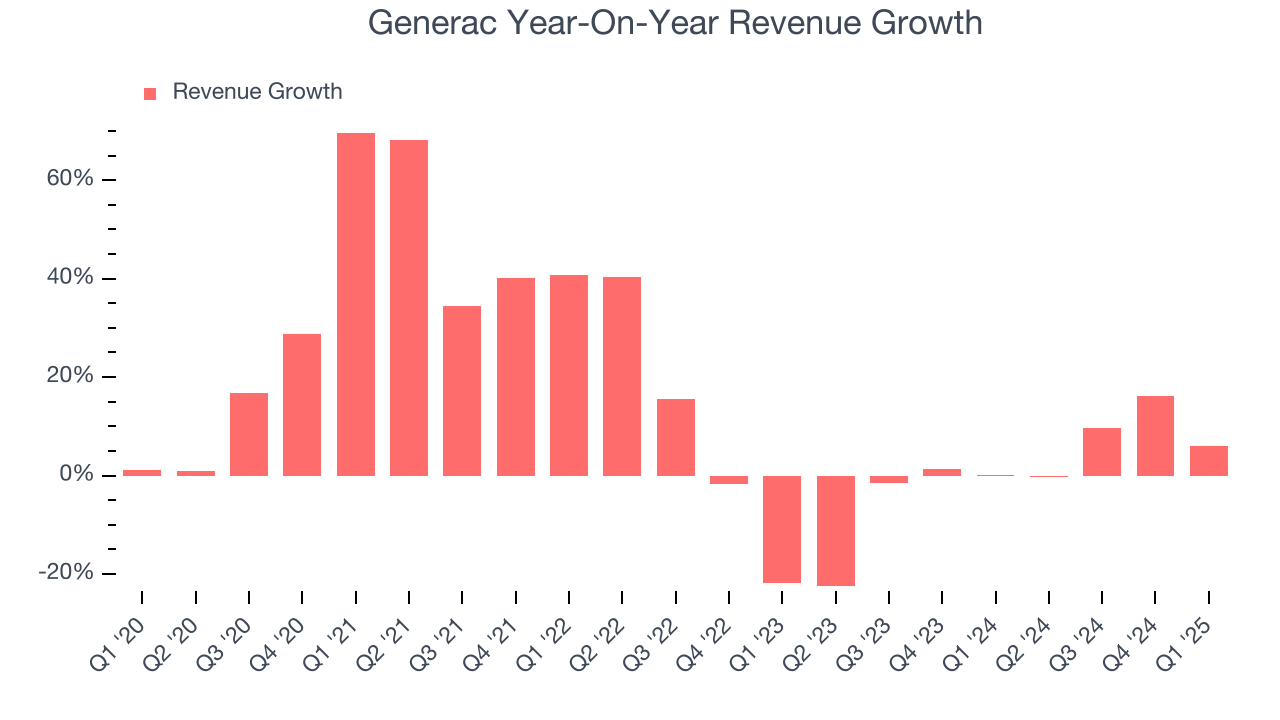
Generac also breaks out the revenue for its most important segments, Residential and Commercial and Industrial, which are 52.4% and 35.8% of revenue. Over the last two years, Generac’s Residential revenue (sales to consumers) averaged 2.9% year-on-year growth while its Commercial and Industrial revenue (sales to contractors and pros) averaged 2% growth.
This quarter, Generac reported year-on-year revenue growth of 5.9%, and its $942.1 million of revenue exceeded Wall Street’s estimates by 2.5%.
Looking ahead, sell-side analysts expect revenue to grow 5.9% over the next 12 months. While this projection indicates its newer products and services will spur better top-line performance, it is still below average for the sector.
6. Gross Margin & Pricing Power
Generac’s unit economics are great compared to the broader industrials sector and signal that it enjoys product differentiation through quality or brand. As you can see below, it averaged an excellent 36.1% gross margin over the last five years. Said differently, roughly $36.13 was left to spend on selling, marketing, R&D, and general administrative overhead for every $100 in revenue. 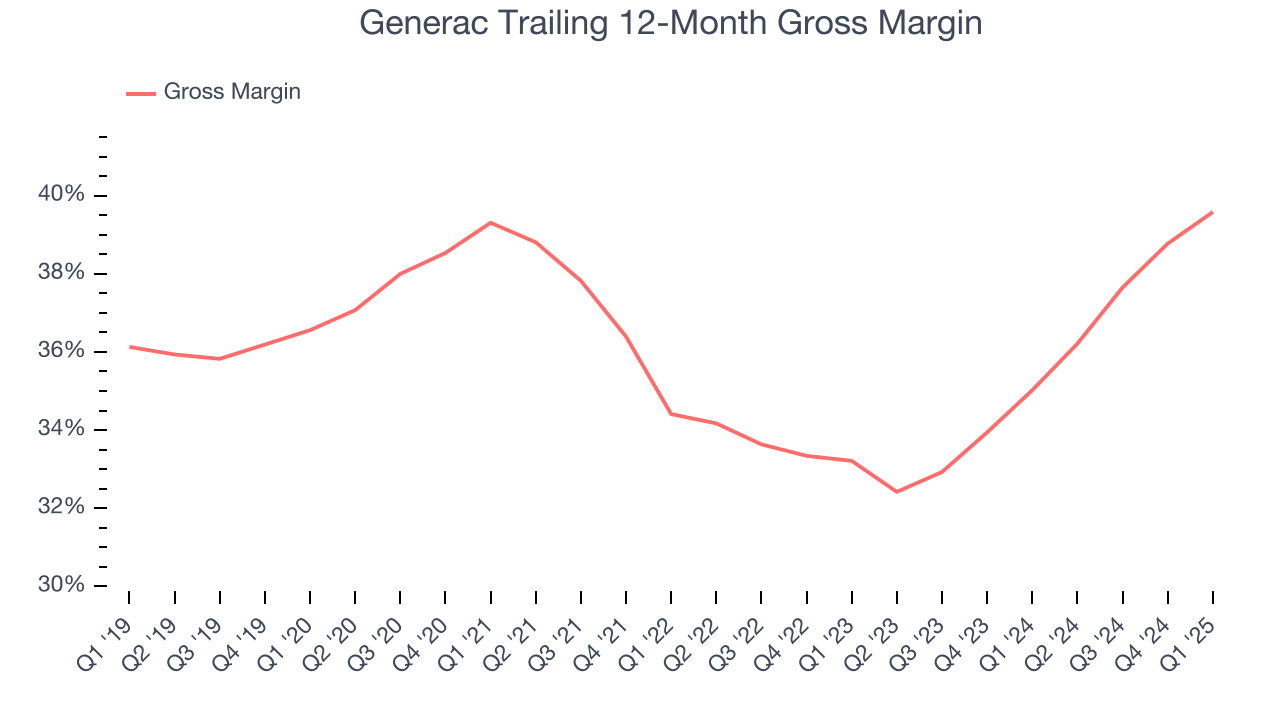
This quarter, Generac’s gross profit margin was 39.5%, marking a 3.9 percentage point increase from 35.6% in the same quarter last year. Generac’s full-year margin has also been trending up over the past 12 months, increasing by 4.6 percentage points. If this move continues, it could suggest better unit economics due to more leverage from its growing sales on the fixed portion of its cost of goods sold (such as manufacturing expenses).
7. Operating Margin
Generac has been an efficient company over the last five years. It was one of the more profitable businesses in the industrials sector, boasting an average operating margin of 13.8%. This result isn’t surprising as its high gross margin gives it a favorable starting point.
Analyzing the trend in its profitability, Generac’s operating margin decreased by 8.8 percentage points over the last five years. This raises questions about the company’s expense base because its revenue growth should have given it leverage on its fixed costs, resulting in better economies of scale and profitability.
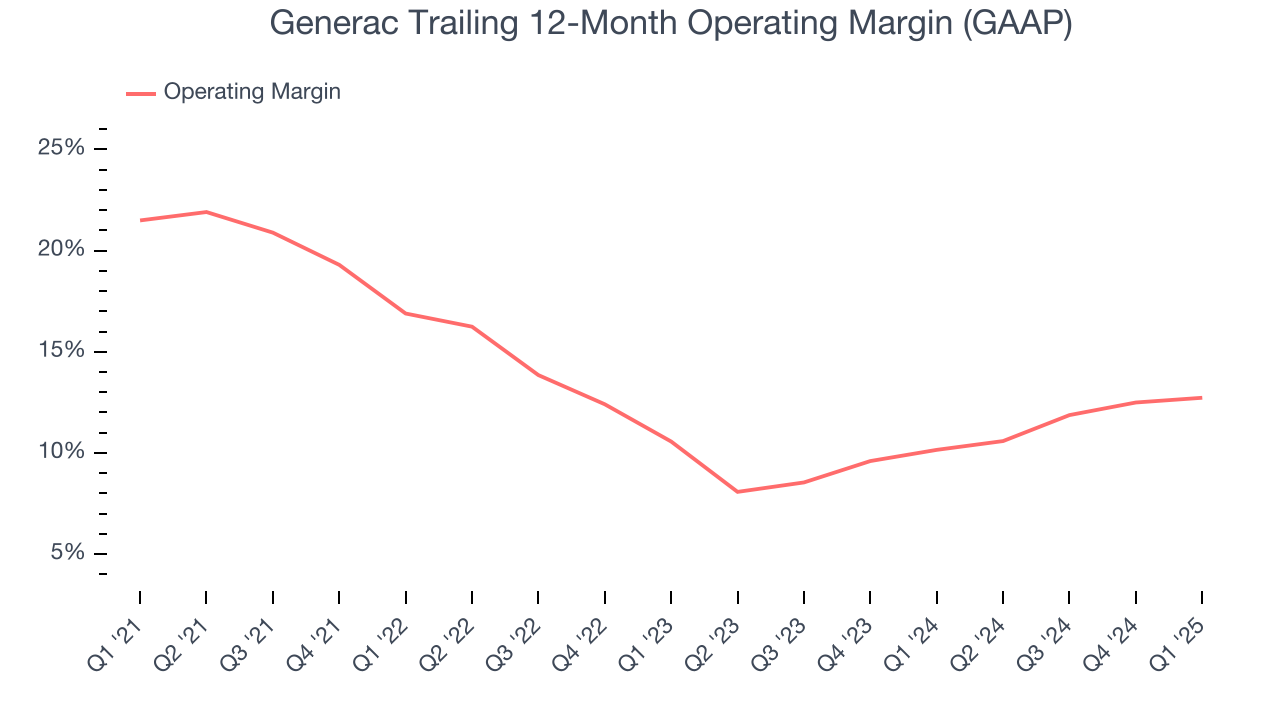
In Q1, Generac generated an operating profit margin of 8.9%, up 1.4 percentage points year on year. Since its gross margin expanded more than its operating margin, we can infer that leverage on its cost of sales was the primary driver behind the recently higher efficiency.
8. Earnings Per Share
Revenue trends explain a company’s historical growth, but the long-term change in earnings per share (EPS) points to the profitability of that growth – for example, a company could inflate its sales through excessive spending on advertising and promotions.
Generac’s EPS grew at a decent 9.5% compounded annual growth rate over the last five years. However, this performance was lower than its 14.5% annualized revenue growth, telling us the company became less profitable on a per-share basis as it expanded due to non-fundamental factors such as interest expenses and taxes.
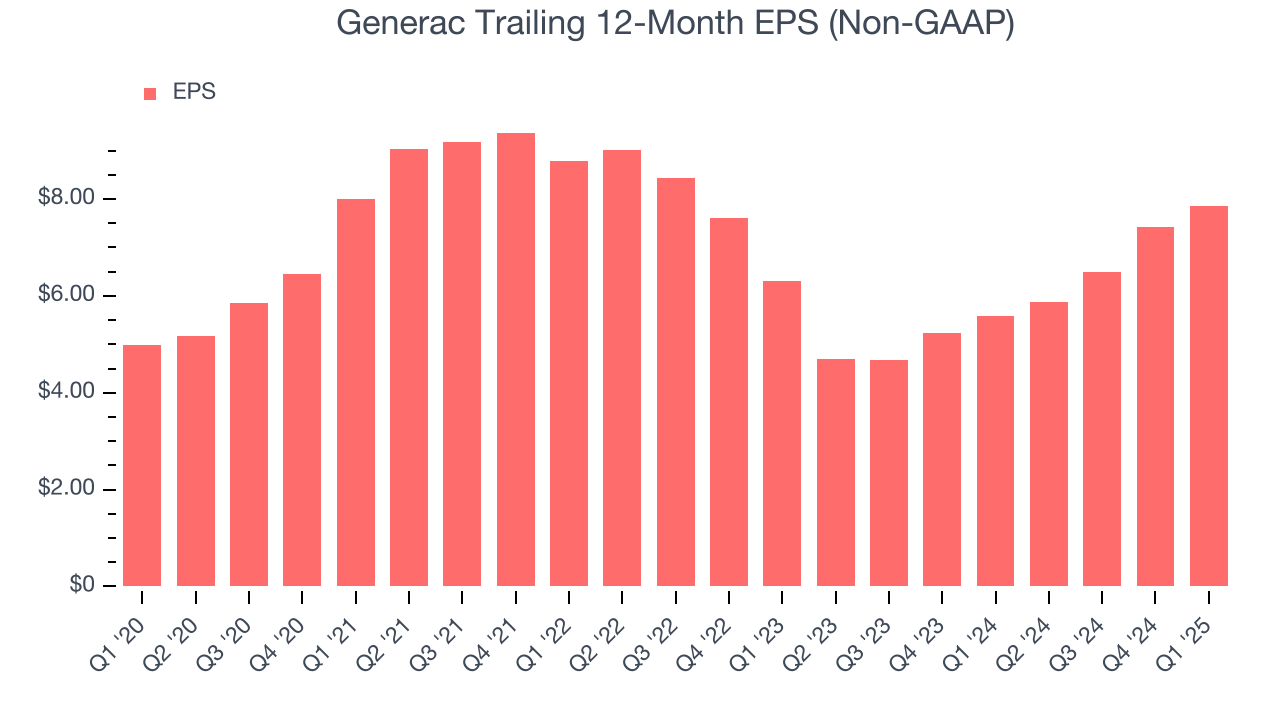
We can take a deeper look into Generac’s earnings quality to better understand the drivers of its performance. As we mentioned earlier, Generac’s operating margin improved this quarter but declined by 8.8 percentage points over the last five years. This was the most relevant factor (aside from the revenue impact) behind its lower earnings; taxes and interest expenses can also affect EPS but don’t tell us as much about a company’s fundamentals.
Like with revenue, we analyze EPS over a more recent period because it can provide insight into an emerging theme or development for the business.
For Generac, its two-year annual EPS growth of 11.7% was higher than its five-year trend. This acceleration made it one of the faster-growing industrials companies in recent history.
In Q1, Generac reported EPS at $1.26, up from $0.83 in the same quarter last year. This print easily cleared analysts’ estimates, and shareholders should be content with the results. Over the next 12 months, Wall Street expects Generac’s full-year EPS of $7.85 to grow 3.5%.
9. Cash Is King
Free cash flow isn't a prominently featured metric in company financials and earnings releases, but we think it's telling because it accounts for all operating and capital expenses, making it tough to manipulate. Cash is king.
Generac has shown impressive cash profitability, enabling it to ride out cyclical downturns more easily while maintaining its investments in new and existing offerings. The company’s free cash flow margin averaged 8.9% over the last five years, better than the broader industrials sector.
Taking a step back, we can see that Generac’s margin dropped by 7.1 percentage points during that time. Continued declines could signal it is in the middle of an investment cycle.
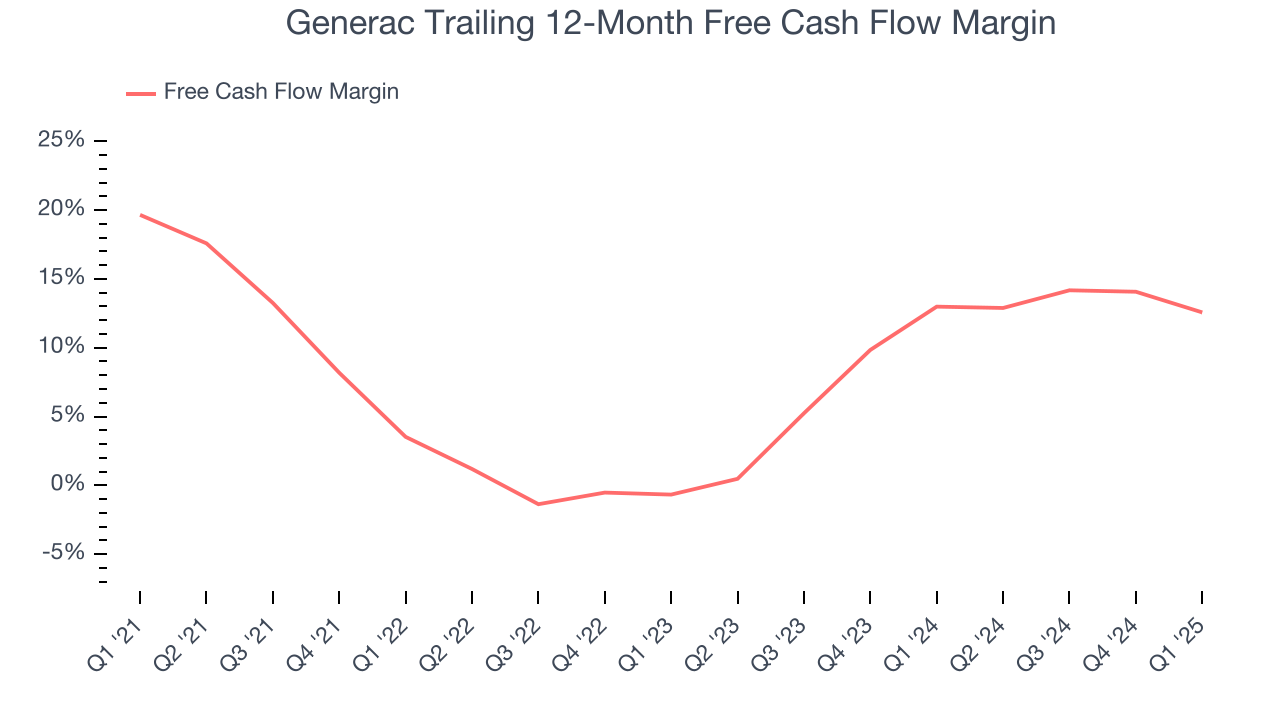
Generac’s free cash flow clocked in at $27.22 million in Q1, equivalent to a 2.9% margin. The company’s cash profitability regressed as it was 6.7 percentage points lower than in the same quarter last year, suggesting its historical struggles have dragged on.
10. Return on Invested Capital (ROIC)
EPS and free cash flow tell us whether a company was profitable while growing its revenue. But was it capital-efficient? A company’s ROIC explains this by showing how much operating profit it makes compared to the money it has raised (debt and equity).
Although Generac hasn’t been the highest-quality company lately, it historically found a few growth initiatives that worked out well. Its five-year average ROIC was 16.5%, impressive for an industrials business.
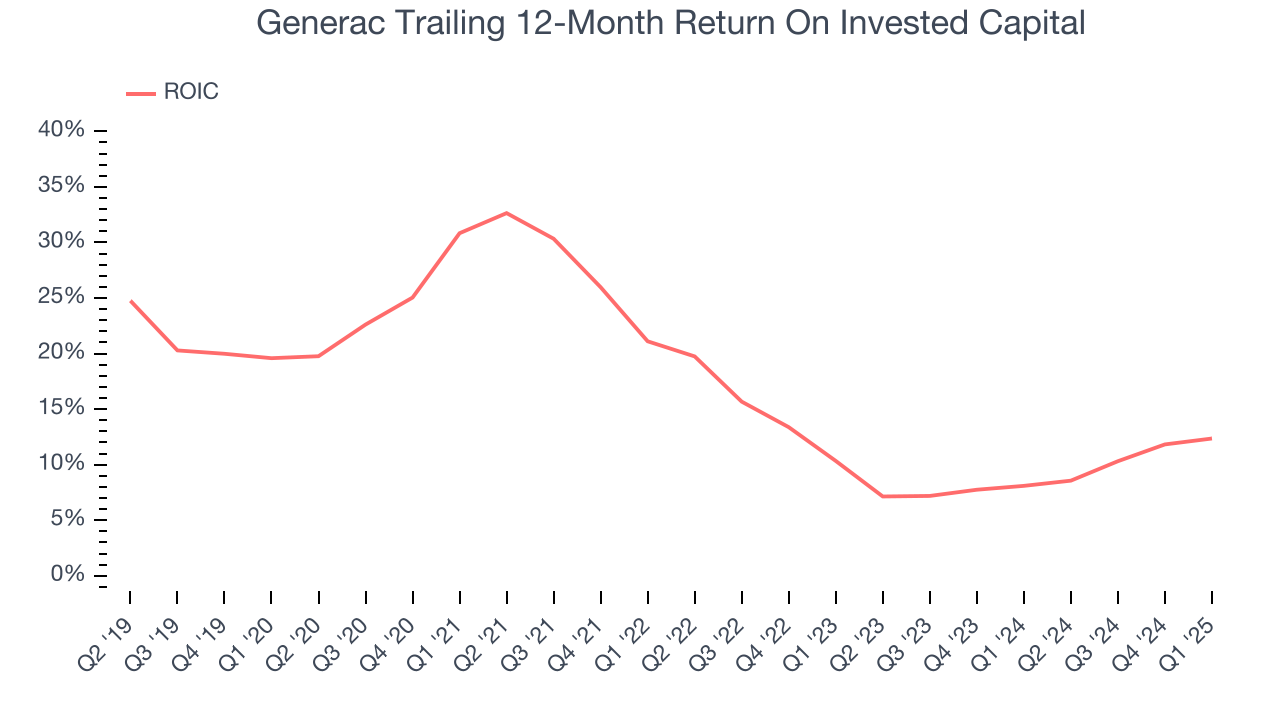
We like to invest in businesses with high returns, but the trend in a company’s ROIC is what often surprises the market and moves the stock price. Over the last few years, Generac’s ROIC has unfortunately decreased significantly. We like what management has done in the past, but its declining returns are perhaps a symptom of fewer profitable growth opportunities.
11. Balance Sheet Assessment
Generac reported $187.5 million of cash and $1.47 billion of debt on its balance sheet in the most recent quarter. As investors in high-quality companies, we primarily focus on two things: 1) that a company’s debt level isn’t too high and 2) that its interest payments are not excessively burdening the business.
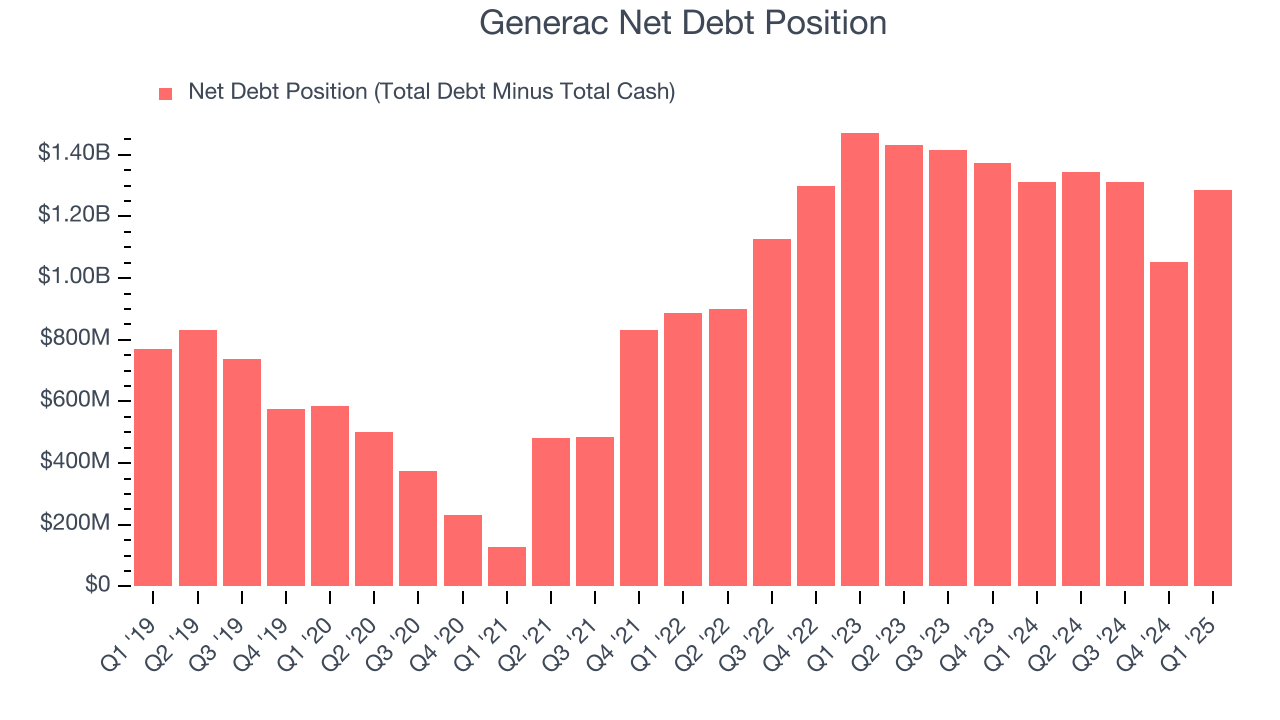
With $810.8 million of EBITDA over the last 12 months, we view Generac’s 1.6× net-debt-to-EBITDA ratio as safe. We also see its $45.31 million of annual interest expenses as appropriate. The company’s profits give it plenty of breathing room, allowing it to continue investing in growth initiatives.
12. Key Takeaways from Generac’s Q1 Results
We liked that Generac beat analysts’ revenue and EPS expectations this quarter. On the other hand, full-year revenue guidance was lowered, and this is weighing on shares. The stock traded down 1.5% to $111.51 immediately following the results.
13. Is Now The Time To Buy Generac?
Updated: May 16, 2025 at 11:38 PM EDT
Are you wondering whether to buy Generac or pass? We urge investors to not only consider the latest earnings results but also longer-term business quality and valuation as well.
Generac’s business quality ultimately falls short of our standards. Although its revenue growth was exceptional over the last five years, it’s expected to deteriorate over the next 12 months and its diminishing returns show management's prior bets haven't worked out. And while the company’s market-beating ROIC suggests it has been a well-managed company historically, the downside is its declining operating margin shows the business has become less efficient.
Generac’s P/E ratio based on the next 12 months is 15.9x. Beauty is in the eye of the beholder, but we don’t really see a big opportunity at the moment. We're fairly confident there are better investments elsewhere.
Wall Street analysts have a consensus one-year price target of $154.62 on the company (compared to the current share price of $129.44).
Although the price target is bullish, readers should exercise caution because analysts tend to be overly optimistic. The firms they work for, often big banks, have relationships with companies that extend into fundraising, M&A advisory, and other rewarding business lines. As a result, they typically hesitate to say bad things for fear they will lose out. We at StockStory do not suffer from such conflicts of interest, so we’ll always tell it like it is.
Want to invest in a High Quality big tech company? We’d point you in the direction of Microsoft and Google, which have durable competitive moats and strong fundamentals, factors that are large determinants of long-term market outperformance.
To get the best start with StockStory, check out our most recent stock picks, and then sign up for our earnings alerts by adding companies to your watchlist. We typically have quarterly earnings results analyzed within seconds of the data being released, giving investors the chance to react before the market has fully absorbed the information. This is especially true for companies reporting pre-market.







